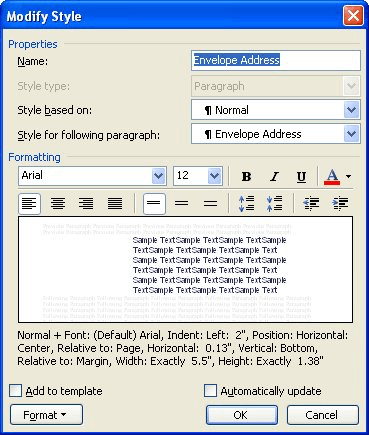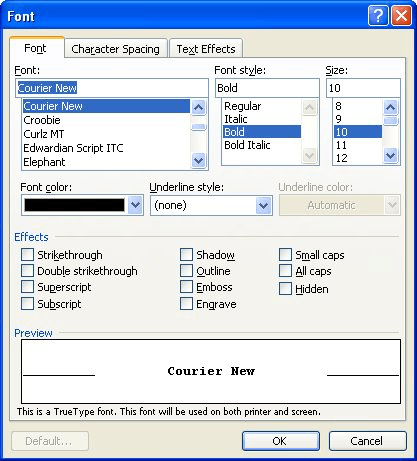Please Note: This article is written for users of the following Microsoft Word versions: 97, 2000, 2002, and 2003. If you are using a later version (Word 2007 or later), this tip may not work for you. For a version of this tip written specifically for later versions of Word, click here: Changing the Default Font for Envelopes.
Written by Allen Wyatt (last updated January 16, 2021)
This tip applies to Word 97, 2000, 2002, and 2003
Word includes an Envelopes feature that makes it pretty easy to create your own professional-looking envelopes. The feature makes certain assumptions about how different parts of the envelope should be printed. This includes the font that Word uses to print the envelope's information.
When creating an envelope, Word depends on predefined styles. The style used for the main address on the envelope is, appropriately enough, Envelope Address. Likewise, the style used for the return address is named Envelope Return. When you instruct Word to create the envelope, these styles are grabbed and used for formatting the addresses on the envelope.
If you want to change the font used by Word in creating envelopes, you need to change the style used for this purpose by Word. To do this, follow these steps if you are using Word 97 or Word 2000:
When done, you should repeat these steps if you want to change the font used for the return address. The only difference, of course, is that in step 4 you should select the Envelope Return style.
If you are using Word 2002 or Word 2003, the steps you follow to make the changes are slightly different. Follow these steps, instead.

Figure 1. The Modify Style dialog box.

Figure 2. The Font dialog box.
Repeat these steps if you want to change the font used for the return address, but in step 4 make sure you select the Envelope Return style.
When you save your document or close Word, you are asked if you want to save your changes to the template. Make sure you do this. Your envelopes, when created in a document that uses this template, should now use the font you specified.
WordTips is your source for cost-effective Microsoft Word training. (Microsoft Word is the most popular word processing software in the world.) This tip (3881) applies to Microsoft Word 97, 2000, 2002, and 2003. You can find a version of this tip for the ribbon interface of Word (Word 2007 and later) here: Changing the Default Font for Envelopes.

The First and Last Word on Word! Bestselling For Dummies author Dan Gookin puts his usual fun and friendly candor back to work to show you how to navigate Word 2019. Spend more time working and less time trying to figure it all out! Check out Word 2019 For Dummies today!
Using the Envelopes and Labels dialog box to print envelopes is quick and easy. It can also be frustrating, however, ...
Discover MoreWhen you create envelopes in Word, you may want to adjust where the return address and main address are printed. Doing so ...
Discover MoreWant to save a bunch of envelopes in a single document so that you can print them all out as a group? Here's how to ...
Discover MoreFREE SERVICE: Get tips like this every week in WordTips, a free productivity newsletter. Enter your address and click "Subscribe."
There are currently no comments for this tip. (Be the first to leave your comment—just use the simple form above!)
Got a version of Word that uses the menu interface (Word 97, Word 2000, Word 2002, or Word 2003)? This site is for you! If you use a later version of Word, visit our WordTips site focusing on the ribbon interface.
Visit the WordTips channel on YouTube
FREE SERVICE: Get tips like this every week in WordTips, a free productivity newsletter. Enter your address and click "Subscribe."
Copyright © 2026 Sharon Parq Associates, Inc.
Comments